

NEWSLETTER
Edited by Claudine Borg (Malta), María Abad Colom (Oslo), Esther de Boe (Antwerp) and Raphael Sannholm (Stockholm)
European Society for Translation Studies EST Newsletter (Vienna)
Dear EST members,
With the academic year and autumn proceeding at full speed, we are pleased to present to you the 63rd edition of the EST Newsletter, brimming with reports on current TIS research, new publications, upcoming conferences, and more.
The theme for the Hot Topics section in this Newsletter is WorkplaceStudies, with a total of nine researchers presenting exciting research focusing on translation workplace practices: Maija Hirvonen, Andrea Hunziker Heeb, Kaisa Koskinen and the Socotrans Research Group headed by Hanna Risku. In the Research Incubator section, Kristiina Taivalkoski-Shilov introduces the research project NarrativeText,Translatorand Machine, focusing on translation technology in literary translation. We also hear from Giada Brighi, the 2023 EST Summer School Scholarship winner, who shares her experiences as a participant in the summer school on translation history at the University of Graz. In addition, the Emerging Voices column features contributions by Elena Pérez Estevan, Laura Picchio, and Alicja Zajdel. This edition also includes conference reports by Luc van Doorslaer, David Orrego-Carmona and Marlie Van Rooyen, Ashley Riggs, and Elisabet Tiselius as well as summer school reports by Jack McMartin and Ricardo Muñoz Martín.
We are very grateful to EST members and colleagues who have contributed to this Newsletter, and we are looking forward to your ideas, suggestions, comments, and contributions for the May 2024 Newsletter via secretary-general@esttranslationstudies.org
All the best!
Claudine,María,EstherandRaphael
November 2023 No. 63 ISSN 3079-7535

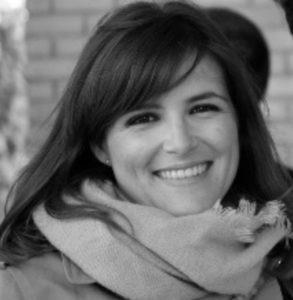


Claudine Borg University of Malta
María Abad Colom OsloMet University
Esther de Boe University of Antwerp
Raphael Sannholm Stockholm University
WordfromthePresident

Dear EST members,
To begin this newsletter, I would like to take a moment to recognize the anguish, sorrow, and fear occasioned by recent events in the world. As human beings, our hearts are heavy in the face of immense suffering. As language professionals who bear witness to and re-present the range of human experience and emotion in our work, we are conscious of the central importance of communication across languages and cultures in working toward mutual understanding, resolution of conflict, and justice. We extend our sincerest sympathy to all those who are suffering and in mourning in various parts of the globe.
For those of you who could not attend our Extraordinary General Meeting last June, I’m happy to report that our proposed changes to the statutes were approved unanimously. We have also had the revised status translated into German (thank you, Maura Calzado, for the translation and Franz Pöchhacker for the careful review) and notified the Austrian authorities of the changes. We are waiting for their ratification. You can find the new version as it was adopted at the meeting in the Members only section of our website under “Constitution”. Contact the Secretary General (or see the email digest of 27 April or 11 May) if you have forgotten the login credentials.
This newsletter features the new Conference and Training Grant. The committee is chaired by Jonathan Downie, with Iwona Mazur and Iris Schrijver agreeing to serve as founding members (thank you!). The grant aims to provide an opportunity for scholars with limited or no means of financial support to attend Translation Studies conferences or training events. The deadline for applications for conferences taking place in 2024 is 15 February. We will award up to five grants in non-Congress years and more in Congress years. I invite you to read the instructions and spread the information.
I would like to take this opportunity to warmly thank Barbara Ahrens and Sonia Vandepitte for their service on the Summer School Scholarship committee, and Sandra Halverson for serving on the Open Access Prize committee. Thank you for sharing your time and competence so generously.
The Leeds Congress website is now up and running here. The call for panels has just opened, so please take the time now to think about proposing a panel for our next Congress.
I wish you a productive winter and look forward to reading and hearing about your contributions to Translation Studies in various forums.
ElisabetTiselius ESTPresident November2023
InitiativesbytheBoard
Updating the Society’s Constitution
An Extraordinary Meeting was held online on 21 June 2023 at 13.00 to present the proposed changes to the Statutes. The revised version approved by the Extraordinary Meeting can be viewed in the password-protected ‘Members area’ of our website, under the ‘Constitution’ tab or by logging into the intranet via this URL https://est-translationstudies.org/intranet/constitution/. The legal constitution is the ratified version in German (Satzung), which prevails over the English version. As soon as the German version has been ratified by the Viennese authorities, the revised English and German versions will be posted on our website.
Launching of the EST Conference and Training Grant
EST is pleased to announce the launch of the EST Conference and Training Grant. This grant offers up to EUR500 of support to EST members wishing to attend conferences of training events, who would not otherwise be in the financial position to attend. In years with an EST Congress, 20 grants will be available for those who wish to attend the Congress. In non-congress years, 5 grants will be available. The closing date for applications for 2024 is 15 February. More details, including eligibility criteria and details of how to apply, are available on the Grants section of the EST website. A dedicated committee, chaired by Jonathan Downie, has been set up.
11th EST Congress in Leeds, United Kingdom, 30 June–3 July 2025
With a little less than two years to go, the organisers of the next EST congress are happy to announce that the Call for Panels is now open!
Over the course of the last decade, the ever-changing landscape of the translation and interpreting industry and academic research has led to practices taking place in different places, platforms and modalities. It has also led to a shift in the profile of the modern translator and interpreter, who are now expected to work in different domains, with different tools, and according to different workflows. Academic research in translation and interpreting studies has also taken on different faces with the multiplication of different areas, tools, and methodologies. This has strengthened our understanding of translation and interpreting phenomena in all their complexity, but has caused a proliferation of discourses about translation and interpreting that do not always coincide or align with industry realities.
In this EST Congress we aim to take stock of these different faces and discourses, and as in previous EST Congresses, the 11th EST Congress will be organised primarily around thematic panels. We welcome proposals for panels related to the general conference theme “The Changing Faces of Translation and Interpreting Studies”, and we are keen to receive submissions adopting a wide range of (inter)disciplinary, methodological, conceptual, professional, historical or geographical perspectives on this theme.
The deadline is 2 February 2024, and we are very much looking forward to receiving your submission. You can find all the details at our Congress webpage, in which we hope to soon announce who the keynote speakers will be.
For now, we leave you with a few fun facts about Leeds... Leeds is mostly famous for its industrial past (the first locomotive was built in Leeds in 1812 by Matthew Murray!), but Leeds is also the home to one of the oldest (and recently renovated) cinema rooms in Europe – the Hyde Park Picture House – which first opened its doors in 1914. Leeds is also the place where the game Cluedo was first published and given that this is one of the most localised games in history, perhaps during the congress coffee breaks we can discuss the challenges it brings to translation!
We are looking forward to welcoming you in Leeds in 2025!
Sara Ramos Pinto
Callum Walker General Planning Committee


Call for Contributions to the Emerging Voices Column
The Emerging Voices in Translation Studies column is dedicated to research by PhD students or recent PhD graduates. We would like to invite members to encourage current or recent students to contribute. We welcome a maximum of three contributions in each issue. Contributions about a PhD dissertation or current project can be accepted from current PhD students or recent PhD graduates who finished their studies within the previous 12 months.
Texts should be no longer than 900 words each (incl. bibliography) and are to follow the guidelines here for the ‘Emerging Voices Column’ section in the EST NL, available when you are logged in at the members section of our website.
Call for Contributions to the EST Research Incubator
Write to us if you would like to share information about a planned or new project and benefit from contacts with other researchers in the EST community. Contributions should be around 200–500 words and are to be sent to secretary-general@est-translationstudies.org. More information here
List of Book Series
As members know, EST keeps track of translation journals. We now also have a list of book series in T&I, which can be viewed on our website in the same online form as the journals. You can find the list here. If you would like a book series to be included, please send an e-mail to secretarygeneral@est-translationstudies.org.
Publications from EST Congresses
If you know of any publications that originated in EST Congresses and are not yet listed on our website here, please let us know by sending the details to secretary-general@est-translationstudies.org
The 2023 Directory of Members
The updated directory of members has been posted on our Intranet. It includes details of members who paid their fees for 2023 and have requested that their names be listed in the directory. If you want to update your details, please send an e-mail to secretary-general@esttranslationstudies.org
Reminder: Discounts from Publishers for EST members
The Society has arranged for members to receive discounts on books from John Benjamins (30%), Bloomsbury (30%), Multilingual Matters (25%), and Brill (30%). In addition, Routledge offers a 30% discount on the most recent titles in their AdvancesinTranslationandInterpreting Studiesseries. Refer to the 'Discounts' page of the password-protected 'Members area' of the EST intranet for more details.
EST-endorsed events
You are welcome to get in touch with us if you are planning an event which you would like us to endorse: secretary-general@esttranslationstudies.org.
Communication Channels and Policies
New publications in Translation Studies come to our attention in various ways (e.g., publishers' websites, information from members through channels such as our online forms and e-mail). Notices about new books that our volunteers manage to scan appear in the biannual Newsletter and most also appear in our social media streams. Notices about new publications do not appear in the biweekly email digest, which for reasons of space focuses on time-sensitive information such as calls for conference submissions, calls for papers, and job opportunities. Please use the online forms accessible from the EST website or from the links listed below if you have information relevant to Translation Studies that you would like to have distributed via our channels.
Reminder: Announcements of Events and Other TS-Related News Items
Thank you for sending us information about books, journal calls for papers, conferences and other news items to post in our Facebook group and Twitter feed. All you need to do is fill in the appropriate form and hit submit. You can also find links to all forms on the EST homepage For announcements of new issues and journal calls for papers: https://goo.gl/forms/hUBT58u8Ejmfi3vC2. For conference announcements and conference calls for papers: https://goo.gl/forms/gdrywrMnaToopn9B2. For general announcements not covered by the other forms: https://goo.gl/forms/wt4lHLg9mCWxiWD43.
We are looking forward to hearing from you.
ESTActivities
Young Scholar Prize Committee

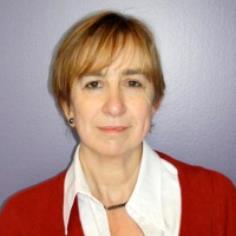
AlineRemael
ChairoftheYoungScholarPrizeCommittee
We would like to invite all 2025 Young Scholar Prize applicants to consult the EST YSP web page at https://esttranslationstudies.org/committees/youngscholar-prize-commitee/young-scholar-prize for updates on who can apply as well as how to apply. The committee has provided more detailed information about the procedure to be followed and the documents to be submitted.
Furthermore, we are happy to welcome Dr. Antonio J. Martínez Pleguezuelos as a new committee member. Dr. Martínez Pleguezuelos is Associate Professor in Translation and Interpreting at the Complutense University of Madrid and has a PhD in Translation from the University of Salamanca. His experience and expertise will be an asset to the committee, which now counts six members once again We are very much looking forward to reading your research.
Open Access Prize Committee

LucvanDoorslaer
ChairoftheOpenAccessPrizeCommittee
The Open Access Prize of 2025 is awarded based on the publications of 2022-2024, so until mid 2024 we have nothing to report
Summer School Scholarship Committee

IlseFeinauer
ChairoftheSummerSchoolScholarship
Committee
Franz Pöchhacker, Müge Isklar and Maria Piotrowska were the other members for 2023 and they have all declared themselves available again for 2024.
We received four applications for 2023 and the decision was unanimous to award the grant to Giada Brighi. You can read more about her, her research, and what the grant meant to her in the Recent TS Events section of the Newsletter.
Applications for the EST Summer School Scholarship will open again next year with the deadline 31 May 2024. Please visit the EST website for more information and the application form.
Translation Prize Committee

IsabelleRobert ChairoftheTranslationPrizeCommittee
Since the next deadline for the EST Translation Prize is 01 October 2024, the Committee has nothing to report at this stage.
We remind our members that the EST Translation Prize (EUR 2,000) is awarded biannually for the most deserving project to translate key texts in Translation Studies (including research on interpreting and localization).
New Conference and Training Grant Committee
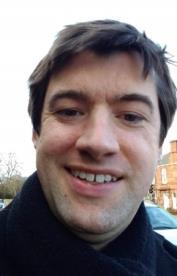
JonathanDownie
ChairoftheConferenceandTrainingGrant Committee
The committee has just been formed and is composed as follows: Jonathan Downie (Chair), Iwona Mazur and Iris Schrijver More details, including eligibility criteria and details of how to apply, are available on the Grants section of the EST website. The deadline for the first round of applications is 15 February 2024
Wikicommittee

KyriakiKourouni
ChairoftheESTWikicommittee
If you are organizing a conference and would like to arrange a Wikipedia workshop, please let us know and we will be happy as always to endorse the event or Edit-a-thons. We invite article writers and editors to record their participation and progress by making appropriate additions to the Wikiproject page. Twitterers and other social media wizards are also warmly encouraged to tweet new articles under the hashtag #tswikiproject
HotTopicinTranslationStudies:WorkplaceStudies
But what about the emic perspective? An ethnographic approach to investigating translation expertise
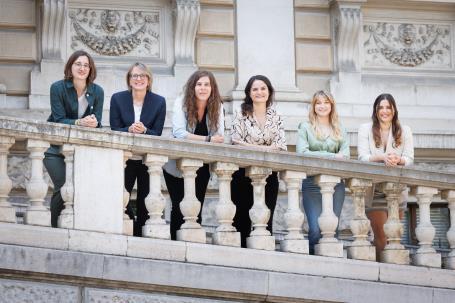
AntoniaBaumann,HannaRisku, DanielaSchlager, ReginaRogl, KerstinPasterk&AnnaSourdille UniversityofVienna
The notion of translation expertise has been discussed in Translation Studies since at least the 1980s when Holz-Mänttäri (1984) described translation as an action realised by an expert (“Expertenhandeln”). Since then, a significant amount of research, particularly within Translation Process Research (TPR) and Cognitive Translation and Interpreting Studies (CTIS), has been conducted to determine what kinds of ‘expertise’, ‘competence’ or ‘skills’ are required in the field of translation.
To date, the majority of research on translation expertise has been carried out in controlled, experimental settings using methods such as think-aloud protocols, eyetracking, keystroke logging, or screen logging. Although this approach provides valuable insights into, for example, some of the indicators that differentiate novices from experienced translators, it only tells half the story. It takes on an etic perspective, examining translation expertise mainly from the researchers’ view. But what does translation expertise actually mean to translators themselves? How is it perceived and conceptualised by working professionals in the language industry? And how is it practised in the authentic context of their workplaces? In order to approach such emic perspectives, we need ethnographic research methods that encompass social, performative, and situative aspects, thereby broadening the limited notion of expertise as merely a system of individual mental processes (Risku and Schlager 2022; Schlager and Risku, forthcoming).
The predominant benefits of this approach lie in its high authenticity, data contextualisation, and expansion of the research scope to include the social, material, and institutional elements that influence translators and their translation processes in the workplace (Ehrensberger-Dow 2014: 366; see also Risku et al. 2022). These influences, along with the
myriad tasks typically undertaken by translators, can be illuminated through workplace research.
Our current project, Rethinking Translation Expertise (RETREX; funded by the Austrian Science Fund FWF) aims at exploring expertise in authentic workplace contexts. The methodologies employed are mainly rooted in ethnographic approaches, particularly cognitive ethnography. Cognitive ethnography deals with the distribution of cognition across individuals and objects, examining how it adapts to facilitate realworld activities as they unfold in natural environments (Hollan, Hutchins, and Kirsh 2000: 179).
Translation workplace research emphasises translation as an activity that surpasses the mere transfer of text from one language to another. Since translators cooperate with others and utilise various tools, it becomes imperative to investigate aspects such as the situated, collaborative, and artefact-mediated dimensions inherent in translation work. The dynamics of interaction and collaboration among diverse stakeholders emerge as pivotal factors within ethnographic approaches (see also Risku et al. 2022). Thus, a central aspect of translation workplace research is the replacement of single texts or isolated processes with real-life workplace environments as the primary analytical units. In our case, these include settings such as language service agencies, in-house translation departments within companies or public service institutions, and virtual translation networks. This shift in focus allows us to explore the day-to-day, contextdependent, and situational work of translators, including their diverse tasks, interactions, and working conditions.
In our current work on the RETREX project, we aim to capture different dimensions of lived expertise through a combination of participant observation, interviews, focus groups, and document analysis. We have employed an ethnographic, multi-case research design, delving deeply into a few selected translation workplaces. To date, we have collected a range of data, including observation protocols, interview transcripts, websites, and biographical data of participants. In total, we have spent 34 days observing (134.5 hours in total) and 13.5 hours conducting 12 interviews in four different cases. We are currently preparing our focus group interviews, which will be held in winter 2023/24.
So far, we have experienced keen interest and even enthusiasm from practitioners when it comes to reflecting on their experience. The translation and interpreting (T&I) professionals we have observed and interviewed wholeheartedly welcomed us to their offices and other operational sites and were eager to demonstrate how they tackle challenges, including those posed by current societal, economic, and technological disruptions. Approaching their emic
perspective enriches scholarly debates and contributes to the relevance of academic research for the life and work of translators, interpreters, and other involved parties, including clients and readers.
While it is true that qualitative field research can sometimes feel like a lonely endeavour amidst TPR/CTIS conferences and workshops that focus predominantly on experimental laboratory research, it is also important to acknowledge the diversity of approaches in our field. Each such approach contributes its own unique insights and advances our collective understanding of T&I practices and processes. Embracing a variety of research methodologies ensures a more comprehensive view of the socio-cognitive complexities and environmental interdependencies in T&I, ultimately benefitting the field as a whole.
References
Ehrensberger-Dow, Maureen. 2014. “Challenges of translation process research at the workplace” In MindingTranslation,R. Muñoz Martín (ed), Special issue of MonTI1: 355–383.
Hollan, James, Edwin Hutchins, and David Kirsh. 2000. “Distributed cognition: Toward a new foundation for human-computer interaction research”. ACMTransactionson Computer-HumanInteraction7 (2): 174–196. Holz-Mänttäri, Justa 1984.Translatorisches Handeln:TheorieundMethode. Helsinki: Suomalainen Tiedeakatemia.
Risku, Hanna, Maija Hirvonen, Regina Rogl, and Jelena Milošević. 2022. “Ethnographic research”. In RoutledgeHandbookof TranslationandMethodology, F. Zanettin and C. Rundle (eds), 324–339. London & New York: Routledge.
Risku, Hanna and Daniela Schlager. 2022. “Epistemologies of translation expertise: Notions in research and praxis”. In Contesting EpistemologiesinCognitiveTranslationand InterpretingStudies, Á. Marín García and S. Halverson (eds), 11–31. London & New York: Routledge.
Schlager, Daniela and Hanna Risku. Forthcoming. “Contextualising translation expertise: Lived practice and social construction”. In TranslationandCognitionin the21stCentury:GoalsMet,GoalsAhead, A. García E. Muñoz and N. Singer (eds), Special issue of Translation,Cognition&Behavior
N.B. This research was funded in whole by the Austrian Science Fund (FWF) [P 33132G]. For the purpose of open access, the authors have applied a CC BY public copyright licence to any Author Accepted Manuscript version arising from this submission.
Micro and macro perspectives to workplace practices

MaijaHirvonen TampereUniversity
Workplace studies cover a wide field that addresses “the relationship between human practices and action on one hand and technologies, ranging from very basic tools and artifacts through to advanced digital systems, on the other” (Heinemann and Matthews 2018: 49). Looking back to its long tradition (see vom Lehn 2018), at the heart of workplace studies’ inquiry is human sociality: how it shapes, organizes and governs work, organizations, and professions. This translates into research of talk-at-work (e.g., Drew and Heritage 1992), collaboration (e.g., Dourish and Button 1998), and cognition (e.g., Resnick et al. 1991; Suchman 1987), to name but a few classic studies. Everyday interaction between human actors as well as between human and technological actors has prevailed as the key element of the practices under study; the knowledge of which has fed into technological design and innovation for decades (see Heinemann and Matthews 2018).
Workplace studies are empirical in the sense of naturalism or ecological validity: human sociality and practices need to be observed and analyzed in the context of their natural occurrence – that is, in the field, and not in laboratory settings. Thus, workplace studies have theoretical and methodological grounding in two traditional strands: ethnography and ethnomethodology. While they share a common premise in grounding the understanding of human practices to the inside of the field (i.e., developing analytical categories and theory from the naturalistic data and the reconstruction of emic perspectives), certain differences exist as well. In what follows, I briefly discuss some of the differences encountered along the way in my microethnographic, conversationanalytical, and ethnomethodological study of collaborative translation processes.
I have spent the past few years disentangling links between collaboration, interaction, and cognition by studying the professional practice of audio description and the teamwork involved in certain fields of audio description (notably, in Finland and the German-speaking parts of Europe). In addition, this has led me to study asymmetrical interaction between blind and sighted team members. This research of workplace interaction has provided answers to questions such as:
- How do humans carry out intelligent action together, in terms of distributing the cognitive processing involved (Korhonen and Hirvonen 2021)?
- What kind of interaction occurs in collaborative translation, in particular as the teams meet to solve translation problems (Hirvonen and Tiittula 2018)?
- How do perceptually asymmetrical interactants organize interaction and construct meaning (of the visuals to the verbal) together (Hirvonen and Schmitt 2018)?
Workplace studies allow different framings of and perspectives on human practice. My research zooms in on the level of human faceto-face interaction and the interactional practices therein That is, I am interested in the “recurrent ways in which linguistic (and other) resources are used for particular purposes, for instance in constructing turns, organizing turn taking, and initiating repair” (Couper-Kuhlen and Selting 2018: 29). The “particular purposes” are context-sensitively defined, thus I have focused on practices of meaning-making, problem-solving, and decision-making, which are constitutive activities in translation. Yet the scope of practice can be very different in other workplace/field studies, for example when broader constellations such as “work-related practices, actors, networks and environments” are studied (Risku et al. 2019: 3). With respect to constitutive differences between ethnomethodological and ethnographic workplace studies, we perceive a difference in perspective (micro/macro) – even if both adopt the participant perspective as the analytical approach. There is also another distinction: While ethnomethodology aims at understanding the accomplishment of mundane practices (typically, their interactional order; Heinemann and Matthews 2018: 47), ethnography is interested in “how practitioners experience it [a specific workrelated practice] in an everyday work context” (Risku et al. 2019: 4).
To counteract the possible shortcomings of the two frameworks and to enrich the view on workplaces, overlapping approaches have emerged. In order to combine the micro and macro perspectives and to understand practices as both accomplished and experienced, one can resort to ethnographical conversation analysis (Deppermann 2000) or to microethnography (Streeck and Mehus 2005). Ethnographic data (e.g., from participant interviews or observation) furnishes vital information for the interpretation of actions in context, while the detailed analysis of moment-by-moment interaction reveals the social structure or culture “in the making”.
References
Couper-Kuhlen, E., and Selting, M. 2018. InteractionalLinguistics:StudyingLanguage inSocialInteraction Cambridge: Cambridge University Press.
Deppermann, Arnulf. 2000. “Ethnographische Gesprächsanalyse: Zu Nutzen und
Notwendigkeit von Ethnographie für die Konversationsanalyse“. Gesprächsforschung 1: 96–124.
Dourish, Paul, and Graham Button. 1998. “On ‘technomethodology': Foundational relationships between ethnomethodology and system design”. Human-ComputerInteraction 13 (4): 395–432.
Drew, Paul, and John Heritage. 1992. Talkat Work.InteractioninInstitutionalSettings. Cambridge: Cambridge University Press. Heinemann, Trine, and Ben Matthews. 2018. “Innovation Communication”. In Handbuch SpracheinOrganisationen, S. Habscheid, A. P. Müller, B. Thörle, and A. Wilton (eds), 45–64. Berlin & Boston: Walter de Gruyter.
Hirvonen, Maija, and Reinhold Schmitt. 2018. "Blindheit als Ressource: Zur professionellen Kompetenz eines blinden Teammitglieds bei der gemeinsamen Anfertigung einer Audiodeskription”. Gesprächsforschung19: 449–477.
Hirvonen, Maija, and Liisa Tiittula. 2018. “How are translations created? Analysis of multimodal interaction as a methodology to study a team translation process” In MethodsfortheStudyofMultimodalityin Translation, C. Jiménez Hurtado, T. Tuominen, and A. Ketola (eds), Special issue of LinguisticaAntverpiensia17: 157–173. Korhonen, Annamari, and Maija Hirvonen. 2021. “Joint creative process in translation: Socially distributed cognition in two production contexts” In Developmentsin CognitiveTranslationandInterpreting Studies, Kairong Xiao and Sandra Halverson (eds), Special issue of CognitiveLinguistic Studies 8 (2): 251–276.
Lehn, Dirk vom. 2018. ”Workplace studies“. In HandbuchSpracheinOrganisationen, S. Habscheid, A. P. Müller, B. Thörle, and A. Wilton (eds), 327–345. Berlin & Boston: Walter de Gruyter.
Resnick, Lauren B., John M. Levine, and Stephanie D. Teasley (eds). 1991. PerspectivesonSociallySharedCognition Washington, DC: American Psychological Association.
Risku, Hanna, Regina Rogl, and Jelena Milosevic. 2019. “Introduction”. In TranslationPracticeintheField:Current ResearchonSocio-cognitiveProcesses, H. Risku, R. Rogl, and J. Milosevic (eds), 1–24. Amsterdam: John Benjamins.
Streeck, Jürgen, and Siri Mehus. 2005. “Microethnography: The study of practices”. In HandbookofLanguageandSocial Interaction, K. L. Fitch, and E. R. Sanders (eds), 24–45. Mahwah, NJ: Lawrence Erlbaum Associates
Suchman, Lucy. 1987. PlansandSituated Actions:TheProblemofHuman-Computer Interaction.Cambridge: Cambridge University Press.
Navigating challenges in workplace studies: a personal perspective

AndreaHunzikerHeeb ZHAWZurichUniversityofAppliedSciences
In two extensive research projects, my fellow researchers and I closely observed professional translators at their workplaces, aiming to comprehend their translation process workflows, resource management, work organization, professional interactions, and ergonomic workplace conditions. In the following, I will discuss various challenges that researchers encounter when venturing into these real-world contexts, illustrating them with anecdotes.
An essential prerequisite for workplace research is to gain access to the professional domains. This entails not only tapping into our personal and professional networks but also articulating the clear benefits that participation brings to individuals or their employers. The need to demonstrate these advantages prompted us to refine our study objectives and construct a robust set of arguments to underscore the significance of our research, which then also proved to be an asset in securing third-party funding. Immediate benefits for participants, such as an ergonomic workplace assessment provided after observations, were very welcome.
The agreement of translators or LSPs to participate is accompanied by the need to address legal, ethical, and technical aspects. These include adherence to stringent data protection standards, considering the sensitive nature of data related to participants, other employees, internal processes as well as any custom-made software solutions. Furthermore, it is of utmost importance to ensure the protection of client data and avoid any potential harm to the translator’s or company’s reputation. All this sometimes requires innovative solutions, such as situating the researcher within the workplace for the duration of the study or ensuring that only anonymized data, or even just the final results, leave the premises.
Since in one of the workplace studies we collaborated with occupational therapists, we explicitly informed them about the intricacies of translation. Initially, they had found translation to be a monotonous task and detrimental to health, perceiving it as mere typing and staring at a screen all day. Our background in translation was instrumental in enabling us to engage effectively with professional translators and to communicate
on an equal footing and with mutual respect. While remaining discreetly in the background during observation sessions, it was sometimes necessary to curb my insatiable curiosity as a researcher, to simply take notes, and to wait until the post-task interview to ask questions This patience paid off, as the translators quickly became used to being observed and went about their business as usual, i.e., no observer effect was apparent. On the screen recordings, I could occasionally see them shopping online, chatting with colleagues about their plans for the weekend, or filling page after page with the same single letter when a power nap at the keyboard seemed to be happening
Besides utmost discretion, flexibility is also a sine qua non in workplace research. Although pilot tests should have been conducted and every location inspected beforehand, Murphy's Law is a constant companion in workplace studies: Technical glitches and human interventions often disrupt the most meticulously organized observations. For instance, arriving punctually with all the necessary equipment only to discover that a simple mismatch in plugs can threaten to derail the entire setup. Or arriving on the agreed day only to learn that the translator has already completed their planned translation work or has had to squeeze in an urgent task unrelated to translation that day.
The benefits of participation also include the possibility of talking to researchers in posttask interviews, which provide participants with a forum to express their work approaches, attitudes, and daily routines. This process facilitates a nuanced understanding of their professionalism and professional ethos, as articulated in their own words. Simultaneously, this triangulation of methods serves to clarify any misunderstandings that may arise during the course of observations. Notably, the perception of interruptions in the workplace made by the observer and the participant being observed may differ. For instance, a freelancer working from home may view the ringing of the doorbell by a postal worker as a brief interruption but not a disturbance, finding it a refreshing break and giving her the opportunity for social interaction. Similarly, a sole translator in a technical company may not mind the calls from her colleagues, because these inquiries signal respect for her linguistic expertise, which she has spent a lot of time and effort earning in the company.
In conclusion, workplace studies, despite their challenges, provide profound insights into professional environments and human behavior. Navigating this intricate terrain demands a delicate balance of curiosity, flexibility, respect, and ethical considerations. As a researcher, I continue to embrace these challenges, recognizing the depth they add to our understanding of the diversity of workspaces and the professionals within them. Through these experiences, we gain not only knowledge but also a profound appreciation for the complexities of the professional world.
This contribution is based mainly on the research projects Capturing Translation Processes (Ehrensberger-Dow et al. 2017) and Cognitive and Physical Ergonomics of Translation (Ehrensberger-Dow and Hunziker Heeb 2016) In the context of these projects and in more recent studies, we have used the knowledge and experience gained to create working environments with high ecological validity in the usability laboratory.
Disclaimer: Parts of this text were produced using DeepL Pro and ChatGPT 3.5.
References
Ehrensberger-Dow, Maureen, and Andrea Hunziker Heeb. 2016. “Investigating the ergonomics of a technologized translation workplace”. In ReembeddingTranslation ProcessResearch, R. Muñoz Martín (ed), 69–88. Amsterdam: John Benjamins. https://doi.org/10.1075/btl.128.04ehr
Ehrensberger-Dow, Maureen, Andrea Hunziker Heeb, Peter Jud, and Erik Angelone. 2017. “Insights from translation process research in the workplace”. In DoingApplied Linguistics:EnablingTransdisciplinary Communication, D. Perrin and U. Kleinberger (eds), 116–123. Berlin: De Gruyter. https://doi.org/10.1515/9783110496604-014
Translating at work: on paraprofessional translation
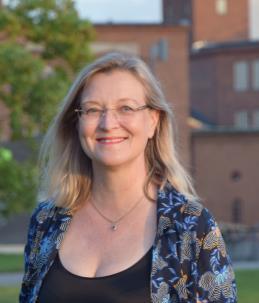
KaisaKoskinen TampereUniversity
Photo (c) Maarit Laitinen/SKTL
Translation Studies has a strong tradition of studying professional translation and interpreting practices and practitioners, and there are many obvious and valid reasons for this emphasis. Many scholars, myself included, either have a background in professional translation or are involved in training future professionals, or both. It is also socially relevant to support the continuous improvement of professional practice through research-based knowledge building. But professional translators and interpreters only cover a fraction of translation activity. Over the past 15 years or so, the study of non-professional practices has therefore grown to cover a wide variety of activist, fan, ad hoc and amateur translating and interpreting and to probe their social relevance.
I now argue that we need to add conceptual nuance to this binary model of professional/non-professional by making a clear distinction between volunteer forms of non-professional translation and another kind of translating or interpreting that takes place within an occupational setting, albeit not by people hired as professional translators. This paraprofessionaltranslation work, i.e., written or oral translating alongside or as part of the task one is employed for, differs from nonprofessional translation that takes place entirely outside of paid work and employment contracts. For example, organizational hierarchy and an employment contract often reduce the voluntariness of translation, and the genres are dictated by the needs of the employer and the task at hand, not by the personal interests and agendas of those who end up translating.
Until now, journalistic translation has been the most extensively studied environment of constant paraprofessional translation (e.g., Davier and Conway 2019). But the phenomenon is much more widespread than
that. We academics engage in it all the time (Penttilä et al. 2021), and so do many others in today’s multilingual workplaces, from CEOs to shopfloor workers. In Translation Studies, there has been a lot of stigma attached to this kind of translation. A classic study of hospital workers doubling as interpreters, among other similar results, shows that there is also reason to be concerned (Pöchhacker and Kadric 1999). But it is also clear that all this paraprofessional translation work will not and could not ever be commissioned from professional translators. It follows that we need empirical data from different workplaces not only to be able to give reasoned advice on when professional translation needs to be done, but also to better appreciate the skills and competences of paraprofessional translators when they succeed in the translation they engage in to get their work done (see, e.g., Koskela et al. 2017).
Modern day businesses and organizations are multilingual and their staff diverse. It is therefore not too surprising that research on translation activities in organizations, more often than not via paraprofessional translation, has become a lively scene. Many of the scholars in international business and management and organization studies have turned to Translation Studies literature for insights and inspiration (see, e.g., Ciuk et al. 2019; Røvig 2023). This growing interest is a testimony to Translation Studies coming of age. We are accustomed to calling this a young discipline, yearning for recognition by others. We are now in a position to contribute to these interdisciplinary discussions (Piekkari et al. 2020; Westney et al. 2022). But the current situation is indeed a bit awkward in the sense that research on paraprofessional translation – to my mind a pressing contemporary research agenda for Translation Studies – is moved forward more by scholars outside our field than by ourselves. I therefore invite and encourage you all to join in by:
- considering whether some of your non-professional translation data actually also qualifies as paraprofessional translation, and if it does, reporting on its features in that particular setting from this perspective; and
- collecting new data from written and oral paraprofessional translation in various organizational settings and workplaces, by people at different hierarchical positions and in different lingua-cultures and multilingual contexts.
Paraprofessional translation is often not fully recognized as such, and formalized translation policies are rare. Paraprofessional translators have not been socialized to professional ethical codes, and they have varied
understandings of their role and responsibilities. While some paraprofessional translators may hold a translation degree, most do not. The varied skills and competences, as well as different and often unverbalized translation beliefs, and the ad hoc nature of many translation events all contribute to a research agenda that requires a lot of empirical observation in the field and extensive textual analysis of the translation products before generalizations can be attempted. As fieldwork has become one of the favorite methods for translation scholars, and as comparative textual analysis holds a traditional center space, Translation Studies is well prepared and welcome to contribute to the discussions already on-going in other fields.
References
Ciuk, Sylwia, Philip James, and Martina Śliwa. 2019. “Micropolitical dynamics of interlingual translation processes in an MNC subsidiary.” BritishJournalofManagement30 (4): 926–942.
Davier, Lucile, and Kyle Conway, eds. 2019. JournalismandTranslationintheEraof Convergence. Amsterdam: John Benjamins.
Koskela, Merja, Kaisa Koskinen, and Nina Pilke. 2017. “Bilingual formal meeting as a context of translatoriality ” Target29 (3): 464–485.
Penttilä, Esa, Juha Lång, Helka Riionheimo, Juho Suokas, and Erja Vottonen. 2021. “Multilingual communication in a researcher's work: Preliminary results of a questionnaire survey.” MikaEL14:62–81.
https://www.sktl.fi/@Bin/2652217/MikaEL14+ +Penttila_Lang_Riionheimo_Suokas_Vottonen .pdf
Piekkari, Rebecca, Susanne Tietze, and Kaisa Koskinen. 2020. “Metaphorical and interlingual translation in moving organizational practices across languages.” OrganizationStudies 41 (9): 1311–1332. Pöchhacker, Franz, and Mira Kadric. 1999. “The hospital cleaner as healthcare interpreter. A case study.” TheTranslator 5 (2): 161–178.
Røvig, Kjell-Arne. 2023. ATranslationTheory ofKnowledgeTransfer:Learningacross OrganizationalBorders. Oxford: Oxford University Press.
Westney D. Eleanor, Rebecca Piekkari, Kaisa Koskinen, and Susanne Tietze. 2022. “Crossing borders and boundaries: Translation ecosystems in international business.” InternationalBusinessReview31 (5): 1–12. https://www.sciencedirect.com/science/article /pii/S0969593122000580?via%3Dihub
EmergingVoicesinTranslationStudies
Bereavement and end-oflife interpreting: a psycholinguistic approach

ElenaPérezEstevan UniversityofAlicante
There is evidence of language barriers resulting in misunderstandings and difficulties in accessing healthcare services by users who do not speak the language of the country they are living in (Silva et al. 2016; Foulquié Rubio et al. 2018; Granhagen et al. 2019). Some studies also focus on professional interpreter-mediated communication as a solution to facilitate understanding in counselling and highly emotional encounters (Costa 2020; Theys et al. 2020).
As a freelance medical interpreter I was particularly interested in exploring the endof-life and bereavement field from the perspective of healthcare (specifically psychotherapy and palliative care) professionals’ views of interpreted consultations versus non-mediated ones, healthcare students’ expectations of the interpreters’ role, interpreters’ self-care, and non-Spanish speaking patients and their relatives as users of these services. Interpreting in this highly emotional context has been given scant attention; it therefore became the topic of my PhD research, aimed at describing the expectations of interpreter-mediated endof-life encounters to draw attention to the needs of users, students, professionals, and interpreters.
To address the topic, I carried out three studies in three stages. In the first, a comparison of non-mediated and professional interpreter-mediated encounters on delivering bad news, an end-of-life situation, and a bereavement therapy session was conducted. We recorded high-fidelity simulations in English, French and Romanian. To analyse the recordings and to test the hypothesis that professional interpreter-mediated situations improve interlinguistic communication we designed a model based on five areas: psychotherapy intervention strategies, politeness, non-verbal and paraverbal communication, emotion
management and conversation management with and without an interpreter. The analysis revealed that when no interpreter was present misunderstandings arose as well as the impossibility of the patient asking questions about the news delivered and healthcare providers experiencing difficulties in perceiving the patient and relative’s emotions. When the interpreter was mediating, healthcare providers could focus on applying psychotherapy strategies and deal with others’ emotions.
In the second stage, a quantitative study was performed. Data on emotions and anxiety were collected from interpreters participating in the first study and questionnaires were also administered to healthcare professionals working in end-oflife units, healthcare students and nonSpanish speaking patients to understand more about their expectations and experiences. Data revealed that interpreters suffered from stress and the fear of not knowing how to deal with emotions, especially in end-of-life situations which took place in patients’ homes rather than in hospital. Professionals and students generally expected interpreters to be confidential, empathetic and impartial, but they did not know where to find professional interpreters (Pérez Estevan 2023a).
The last stage was a qualitative study in which I conducted 71 interviews with healthcare professionals and 35 with nonSpanish speaking users plus a focus group with the interpreters who took part in the first study. Results showed that interpreters experienced difficulties in their role as they did not know what healthcare professionals expected from them in terms of psychotherapy intervention strategies and politeness. None of the users interviewed had a professional interpreter provided by the healthcare system, so they had to pay for interpreting services, and some of them did not know where to get a professional one, so had to use ad-hoc interpreters (Pérez Estevan 2023b). They also mentioned the impossibility of attending bereavement therapies in Spain because no interpreters were provided. Professionals’ answers supported the results of the quantitative study.
These findings are interesting because they suggest the need for better teamwork and training on how to work with interpreters in end-of-life and bereavement contexts. Institutions are also called upon to regulate and professionalise medical interpreters in Spain because they are not always guaranteed by law in the national health system (Lázaro Gutiérrez and Álvaro Aranda 2020: 71).
References
Costa, Beverley. 2020. OtherTongues: PsychologicalTherapiesinaMultilingual World. Monmouth: PCCS Books
Foulquié Rubio, Ana Isabel, Mireia Vargas Urpi, and Magdalena Fernández Pérez (eds.). 2018. Panoramadelatraduccióny lainterpretaciónenlosserviciospúblicos españoles.Unadécadadecambios,retosy oportunidades. Granada: Comares.
Granhagen Jugner, Johanna, Elisabet Tiselius, Klas Blomgren, Kim Lützén, and Pernilla Pergert. 2019. “Language barriers and the use of professional interpreters: A national multisite cross-sectional survey in pediatric oncology care.” Actaoncológica 58 (7): 1015–1020. https://pubmed.ncbi.nlm.nih.gov/30958083
Lázaro Gutiérrez, Raquel, and Cristina Álvaro Aranda. 2020. “Public service interpreting and translation in Spain”. In Trainingpublicserviceinterpretersand translators:AEuropeanperspective, edited by M. Štefková, K. Kerremans, and B. Bossaert, 71–87. Bratislava: Comenius University of Bratislava.
Pérez Estevan, Elena. 2023a. “Interpretermediated end-of-life encounters in Spain: Mapping the Spanish situation based on healthcare providers’ input.” In Newtrends inhealthcareinterpretingstudies, edited by R. Lázaro Gutiérrez and C. Álvaro Aranda, 157–172. Singapore: Springer.
Pérez Estevan, Elena. 2023b. “La voz de los pacientes alófonos: Un estudio exploratorio de sus experiencias con intérpretes sanitarios en España.” FITISPos InternationalJournal10 (1): 112–129. https://fitisposij.web.uah.es/OJS/index.php /fitispos/article/view/349
Silva, Milagros, Margaux Genoff, Alexandra Zaballa, Sarah Jewell, Stacy Stabler, Francesca Gany, and Lisa Diamond. 2016. “Interpreting at the end of life: A systematic review of the impact of interpreters on the delivery of palliative care services to cancer patients with limited English proficiency.” JournalofPainand SymptomManagement51 (3): 569–580. https://pubmed.ncbi.nlm.nih.gov/26549596
Theys, Laura, Demi Krystallidou, Heidi Salaets, Cornelia Wermuth, and Peter Pype. 2020. “Emotion at work in interpretermediated consultations: A systematic literature review.” PatientEducationand Counseling103: 33–43. https://pubmed.ncbi.nlm.nih.gov/31431309
Self-perceptions of audio describers: Does how you see yourself affect how you describe?
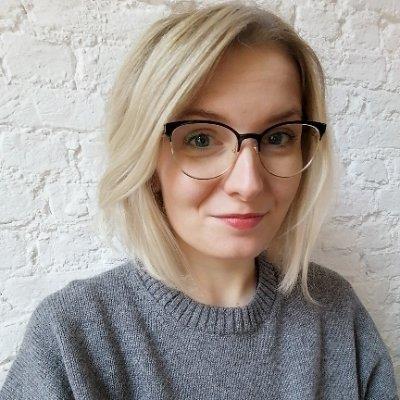
AlicjaZajdel UniversityofAntwerp
Audio Description (AD) is still a relatively young profession with “fuzzy, porous professional boundaries”, as no official training or accreditation is required to enter it (Ruokonen et al. 2018: 7; Chmiel et al. 2019). This means that audio describers are a very heterogeneous group, coming into the profession through various entry routes and educational backgrounds. While AD is generally considered a form of audiovisual translation, in practice it is often done by professionals without any foreign language knowledge or translation training (ADLAB PRO 2017: 47). Previous studies have also suggested that describers might conceptualise AD in different ways, for example comparing themselves to scriptwriters, translators or authors (ADLAB PRO 2017: 39). This creates an interesting context to study the AD profession and the processes involved in AD script writing.
My ongoing PhD project investigates how audio describers perceive themselves as professionals with the aim to identifying various profiles that might exist. I hypothesise that describers might approach
AD differently based on whether they view the task as a form of translation or writing. To explore this question in my project, I turn to existing text production models from both translation and writing process research in order to establish a similar model for AD scriptwriting. This project, therefore, raises a fundamental question: is AD translation or writing? Perhaps it is its own form of text production, and perhaps the answer to this question depends on who performs the task.
As a starting point, I conducted an online questionnaire to gain a better understanding of the professional context in which audio describers work. Building on the ADLAB PRO project, the questionnaire explored the working conditions, status perceptions and job satisfaction of audio describers. The results show that, while AD is a highly creative job that requires expert skills, these skills are not always recognised and AD as a profession does not enjoy a high level of prestige or visibility. The lack of understanding of what AD entails and the processes involved in its creation was one of the major themes that emerged in my study, indicating that more awareness of AD is needed, even among industry professionals.
Following on from the questionnaire, I turned online to collect interviews with audio describers, blog posts, podcast episodes, websites of service providers and personal websites of audio describers. I analysed this small corpus to see how audio describers present themselves online and which skills or aspects of the profession they highlight. The following themes emerged during the thematic analysis: love of language and wordsmithing, interest in film/theatre, passion for accessibility services and, for those involved in voicing AD, affinity for performing. I am currently conducting individual interviews with describers to
delve into these themes deeper by exploring participants’ personal journeys into AD.
The next part of the project will involve an experiment in which describers will be grouped by their professional profile and their working processes will be analysed using keylogging, TAPs and retrospective interviews. At the moment I am working on developing a profiling tool, based on the data collected in the online content analysis, interviews and (upcoming) focus groups. This will allow me to profile participants for the experiment, and I hope that this tool will be useful outside the scope of this project as a way of mapping out different approaches to AD.
References
ADLAB PRO. 2017. Report on IO2: Audio description professional: Profile definition. https://www.adlabpro.eu/intellectualoutputs/io2-audio-description-professionalprofile-definition/
Chmiel, Agnieszka, Iwona Mazur, and Gert Vercauteren. 2019. “Emerging competences for the emerging profession: A course design procedure for training audio describers”. TheInterpreterand TranslatorTrainer13 (3): 326–341. https://doi.org/10.1080/1750399X.2019.16 56408
Ruokonen, Minna, Leena Salmi, and Elin Svahn. 2018. “Boundaries around, boundaries within: Introduction to the thematic section on the translation profession, translator status and identity”. HERMES-JournalofLanguage andCommunicationinBusiness58: 7–17. https://doi.org/10.7146/hjlcb.v0i58.111655
Dialogue interpreting between cinema and digital media
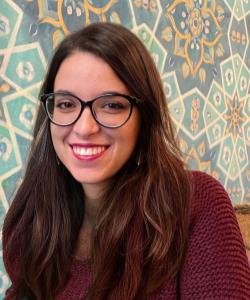
LauraPicchio UniversityofMacerata
The digital turn has changed every aspect of our lives, including the media ecosystem and dialogue interpreting performances. To this end, my doctoral thesis (Picchio 2023) analyses whether and how web streaming via YouTube, as well as distance interpreting, impact both the provision of consecutive dialogue film festival interpreting (FFI) services (Merlini 2017) and their reception by potential users. The analysis focuses on audience design, interpreters’ agency and their visibility on screen, adopting a mixed methods design.
The qualitative strand includes the analysis of a multimodal corpus of authentic interpreting performances (IT<>EN) taken from the latest editions (2017–2020) of the Giffoni Film Festival, an important Italybased international festival which addresses a young audience Some of its events are live-streamed, and in 2020 it used distance interpreting as well. My corpus consists of both onsite- and distance-streamed events, but also onsite non-streamed events. The analysis of audience design draws on Bell’s (e.g., 1984) theoretical framework, whilst agency is investigated as follows: starting from space positioning (Pokorn 2015), I move onto a dual approach of considering footing (Goffman 1981; Wadensjö 1998) and discursive positioning (Davies and Harré 1990; Mason 2005; Merlini 2009), before focusing on the ethics of entertainment (Katan and Straniero Sergio 2001) Visibility on screen is analysed in multimodal terms (e.g., Davitti 2018). The quantitative strand is composed of two questionnaires. The first one focuses on expectations about online audiovisual contents and interpreting performances. The second deals with audience design and visibility with examples taken from my corpus: five excerpts focus on appropriateness (Viezzi 1996) strategies of cinema-related terms; and five clips show an increasing visibility on screen of interpreters’ gestures. The quantitative strand is supported by secondary statistical data (e.g., We are social 2022) in terms of media-digital consumption.
The corpus analysis shows that both the live-streaming and the remoteness make the under-investigated setting of FFI
different from traditional TV interpreting (e.g., Straniero Sergio 2007). This is particularly true in terms of agency and visibility on screen, but also with reference to some audience design-focused analyses. Usually, the Giffoni interpreters address the onsite jurors rather than the streaming users, the latter becoming more involved in remote scenarios. Some footings and positionings are peculiar to these online settings and the ethics of entertainment is less present and rarely initiated by interpreters. Moreover, in general the FFI interpreters resemble simultaneous interpreters more than consecutive ones since they are usually invisible on screen; however, they become more visible in remote encounters.
The analysis of expectations shows that neither (a) audience design nor (b) visibility on screen is considered to be important. On the contrary, after reading/watching the authentic excerpts, most of the respondents (young Italian people) (a) positively value the appropriateness strategies interpreters used and (b) argue that interpreters are to be visible on screen to highlight their professional status and strengthen the intelligibility of interactions. These findings may be helpful for professionals to produce ever more appropriate renditions and for the festival management to realise interpreters should be visible on screen.
The data I analysed may be used for didactic purposes as well. A (socio-) constructivist pedagogic model (Picchio and Merlini 2022) shows how the multimodal contents available on YouTube can be used to educate dialogue interpreters, both in similar media-related contexts, and in very different situations such as healthcare, for instance through the adoption of a CARMlike (Niemants and Stokoe 2017) method.
References
Bell, Allan. 1984. “Language style as audience design”. LanguageinSociety13 (2): 145–204.
https://doi.org/10.1017/S00474045000103 7X.
Davies, Bronwyn, and Rom Harré. 1990. “Positioning: The discursive production of selves”. JournalfortheTheoryofSocial Behaviour20 (1): 43–63. https://doi.org/10.1111/j.14685914.1990.tb00174.x.
Davitti, Elena. 2018. “Methodological explorations of interpreter-mediated interaction: novel insights from multimodal analysis”. QualitativeResearch19 (1): 7–29. https://doi.org/10.1177/146879411876149 2.
Goffman, Erving. 1981. FormsofTalk Oxford: Basil Blackwell.
Katan, David, and Francesco Straniero Sergio. 2001. “Look who’s talking. The ethics of entertainment and talk show
interpreting”. TheReturntoEthics.Special issueofTheTranslator7 (2): 213–237. https://doi.org/10.1080/13556509.2001.10 799102
Mason, Ian. 2005. “Projected and perceived identities in dialogue interpreting”. In IATIS Yearbook2005, edited by J. Munday, 30–52. Seoul: IATIS.
Merlini, Raffaela. 2009. “Seeking asylum and seeking identity in a mediated encounter”. Interpreting11 (1): 57–92. https://doi.org/10.1075/intp.11.1.05mer
Merlini, Raffaela. 2017. “Developing flexibility to meet the challenges of interpreting in film festival”. In Teaching DialogueInterpreting.Research-based ProposalsforHigherEducation, edited by L. Cirillo and N. Niemants, 137–157. Amsterdam: John Benjamins.
Niemants, Natacha, and Elizabeth Stokoe. 2017. “Using the conversation analytic roleplay method in healthcare interpreter education”. In TeachingDialogue Interpreting.Research-basedProposalsfor HigherEducation, edited by L. Cirillo and N. Niemants, 294–321. Amsterdam: John Benjamins.
Picchio, Laura. 2023. “L’interpretazione dialogica tra cinema e media digitali: il Giffoni Film Festival come caso di studio”. PhD diss., University of Macerata.
Picchio, Laura, and Raffaela Merlini. 2022. “Using YouTube for dialogue interpreters’ professional development: A constructivist approach to self-learning”. Abstract of the paper presented at the 10th EST Congress, June 22–25, 2022, Oslo: 170–171. Accessed July 24, 2023. https://www.hf.uio.no/ilos/english/research /news-andevents/events/conferences/2022/est22/pro gram/est22-oslo-abstract-booklet/est22abstract-booklet.pdf
Pokorn, Nike K. 2015. “Positioning”. In RoutledgeEncyclopediaofInterpreting Studies, edited by F. Pöchhacker, 312–314. London and New York: Routledge.
Straniero Sergio, Francesco. 2007. TalkshowInterpreting:LaMediazione linguisticanellaConversazionespettacolo Trieste: EUT.
Viezzi, Maurizio. 1996. AspettidellaQualità inInterpretazione. Trieste: SSLMIT.
Wadensjö, Cecilia. 1998. Interpretingas Interaction. London and New York: Longman.
We are social. 2022. “Digital 2022. Global overview report”. Accessed August 30, 2023.
https://www.slideshare.net/DataReportal/di gital-2022-global-overview-report-january2022-v05
ResearchIncubator
Narrative Text, Translator and Machine: In Search of User-Friendly Translation Technology for Literary Texts
2022–2026, funded by the Academy of Finland, project 350409
Principal investigator: Kristiina Taivalkoski-Shilov, University of Turku, Finland
Project team: Claudine Borg, Teemu Ikonen, Aleksandra Konovalova, Maarit Koponen, Lauri Niskanen, Minna Ruokonen, Leena Salmi, Teemu Vahtola
While technology-assisted translation has been a commonplace in the translation of non-literary texts for decades, very little use has been made of translation technology in literary translation so far. The only link that is nowadays quite often drawn between translation technology and literary translation is the lay speculation that, with the development of machine translation, human translators will soon no longer be needed. However, previous research on the subject has shown that machine translation is ill-suited to literary translation, even when it is post-edited by professional literary translators. One of the starting points of our study is the hypothesis that literary translators instead need CAT tools (which may include machine translation as a component) that can be tailored to their specific needs.
The aim of our multidisciplinary research project is to gather information on the technology needs of Finnish literary translators and their attitudes and feelings towards technology. In addition, we are studying the structure of narrative texts and exploring how to model narrative information. The project, which includes nine researchers, consists of subprojects involving a multitude of task-specific methods, ranging from ethical analysis, an anonymous online survey, semi-structured interviews and autoethnographic translation process research to narratological analysis, machine learning and deep learning. At the end of the project, a prototype of a literary CAT tool will be developed that will be tested and improved with the help of task-based usability studies.
For more information, see https://sites.utu.fi/littra/en/
RecentTSEvents
Conference Report: Translation and the News & Researching and Applying Metaphor (RaAM) Conferences
I was fortunate enough to attend two excellent conferences in June and I’m pleased to have this opportunity to share some information and highlights, as I think these events and their future editions will be of interest to our community.
The first was Translation and the News: state of the art, dialogues, reflections (26–27 June), organized by the Universidade Católica Portuguesa in Lisbon.
This event was small in scale, almost familial, but also of a high calibre and resolutely international. It was a major success thanks to both the quality of the contributions, and the excellent organisational skills and delightful personalities of our colleagues at Católica.
The three plenary speakers were, in order of appearance, Roberto Valdeón, who presented “Thirty Years of Journalistic Translation (Research)”; Lucile Davier, with a contribution entitled “Emic Voices in the Media: how Swiss and Canadian journalists understand translation”; and Nelson Ribeiro, with “An Invisible Locus of Power: translated news in Portugal during World War II”, during which we learned fascinating details about the recent history of our host city and country.
The panel topics were: the (in)visibility of translation/translators in the news; power, news and translation; researching routines of news translation in different venues; science newsmaking in translation; health in news translation; indirect translation in the news; and the impact of (un)translatability and cultural difference on news translation. All the contributions were relevant and engaging; I’d like to highlight, if I may, Jane Duarte’s presentation, “Pen or Sword? Journalist meets translator in the ESP/Translation Classroom,” about her pedagogical pilot project which brought TS and media studies students together to collaborate on various tasks, including newswriting/news translation. The project merits replication by other programmes, especially given the stated goal of journalistic translation studies – but also the challenges – of raising awareness, improving communication and creating synergies between this TS subdiscipline, on the one hand, and journalism studies, media studies, communication studies and journalists, on the other.
At the opposite end of the spectrum in size and scope was the 16th edition of the Researching and Applying Metaphor (RaAM) conference that took place immediately afterward, from 28 to 30 June. It was held at the historic, stunningly beautiful Universidad de Alcalà (Alcalà de Henares, Spain; the birthplace of Cervantes), which co-organized the event with the Universidad Autónoma de Madrid. The theme this year was Metaphor in Public Discourse, and panels on metaphor/metonymy and gender, activism, COVID-19, (mental) health, education, the arts, evaluation, scientific discourse, politics, the press, social media, corpora, psychology, neural linguistics, and theory, amongst others, attest to the pervasiveness of figurative language in such discourse, the inherent interest of the topic and the breadth of attention it is receiving in academia.
The conference also included three plenary lectures: in order of appearance, Andreas Musolff on “Metaphor, Public Discourse and Conspiracy Theories”; Augusto Soares da Silva’s contribution, “Metaphor and intersubjectivity: evidence from emotions, morality and politics”; and Solange Vereza’s lecture, “Weaving Viewpoints through Metaphoric Mappings in Discourse”.
The numerous presentations and poster contributions, in particular by early career researchers, on the use of metaphor and metonymy in climate change activism, including from visual/multimodal perspectives, were particularly fascinating. These included, for instance, Anais Augé’s presentation, entitled “The Red Rebel Brigade and the Blood Bath: artivism and the visual impact of metaphors”; Kimberly Grogan’s poster on “Multimodal Metaphor and Climate Change Activism”; and Niamh O’Dowd’s presentation on “The Potential of Creative Uses of Metonymy for Climate Protest”.
The conference proper was preceded by two workshops (27 June), on Deliberate Metaphor Theory (led by Gerard Steen), and metaphor translation in the world of wine (led by Allison Creed and Lettie Dorst). Our discipline was also represented in various panels, with presentations on, for instance, “Icons, Logos, Visual Metaphor and the Public Representation of Translation” (Mark Shuttleworth and Ziyu Xu), “Frame-Based Terminology” (EN, SP and AR corpus): systematic metaphor analysis in climate change discourse” (Amal Haddad Haddad), or Lettie Dorst’s contribution on “The Role of Metaphor in Students’ Conceptualizations of Machine Translation and the Influence of Public Discourse on Artificial Intelligence”.
If your research involves metaphor, metonymy, or other types of figurative language, and their real-life manifestations and effects, this biannual conference should be on your radar. RaAM 17 will be held at Lawrence Technical University, Southfield, MI (USA) in July 2025.
AshleyRiggs Ca’FoscariUniversityofVenice
Conference Report: Fourth International Conference on Translation, Interpreting and Cognition ICTIC4
The fourth edition of the ICTIC conference was held on September 6–8 at the Centro de Estudios de Postgrado y Educación Continua (CEPEC), Universidad de Santiago de Chile. It was organized jointly by the Interdisciplinary Program on Communication and Cognition (PIIECC, Universidad de Santiago de Chile) and the Cognitive Neuroscience Center (CNC, Universidad de San Andrés). The conference was sponsored by EATRI and Pontificia Universidad Católica de Valparaíso. The theme of the conference was “Methods we live by”. The aim of the organizers was to scrutinize the different methods used in Cognitive Translation and Interpreting studies. The organizers invited participants to reflect on how methods have progressed, which new developments the field has seen, how they can be applied, and how to overcome limitations.
There were two official conference languages (Spanish and English), and the interpreting students at the university demonstrated a very strong performance in rendering the sometimes very dense and abstract talks into the two languages.
Keynote speakers were Fabio Alves, Michael Carl, Amparo Hurtado Albir (online), and Defeng Li. The keynote speakers focused on their respective areas of expertise and gave an overview of their methods and field both in retrospect and, especially for Defeng Li, in anticipation. The day before the conference, two workshops were organized: one by Fabio Alves on retrospection in translation process research; and the other one by Michael Carl on empirical translation process research with the CRITT TPR database as a case in point.
The conference gathered roughly 50 participants from 3 continents, with EST well represented among the presenters. It was also very nice to see the large body of local MA students who attended the talks. The talks covered translation, machine translation, AI, spoken and signed language interpreting, sub-titling, T&I pedagogy, and augmented reality. The organizers also arranged for two recordings of round table discussions, one focusing on methods and the other on publishing, which will be posted on the YouTube channel “Minds between languages”.
During the conference, the TREC Network also held its general meeting, appointing a new management committee consisting of Jan-Louis Kruger, Sixian Lao, Christopher Mellinger, and Elisabet Tiselius.
The thematic organization of the conference with a mixture of two streams for research presentation, and a single stream for the keynotes and panels made the conference interactive and coherent.
StockholmUniversity

Photo by: Luciano Guzmán
ElisabetTiselius
Conference Report: Third Conference of the Association for Translation Studies in Africa (ATSA)
The Third Conference of the Association for Translation Studies in Africa (ATSA) was hosted by the Advanced School of Translators and Interpreters (ASTI) from 20 to 24 June, in collaboration with the Pan African University Translation, Interpreting and Intercultural Communication Programmes (PAUTRAIN) at the University of Buea in Cameroon, at the foot of Mount Cameroon.
The conference theme, “Contemporary Issues in Translation, Interpreting and Intercultural Mediation” allowed for a range of presentations, showcasing a variety of areas in translation and interpreting studies from the translation and interpreting market in Cameroon to Bible translation, translation technologies, feminist translation studies, translaboration, ethics and risk in translation, and translator and interpreter education, among other topics. While the conference focused on the realities of translation and interpreting in Africa, the presenters came from four continents, namely Africa, Asia, Europe, and the Americas.
The keynote speech was delivered online by Professor Mona Baker on the topic “Narrative and discourse: Advantages and limitations” and set the ground for engaging discussions about the evolving landscape of translation studies in Africa and globally, addressing the most pertinent challenges and opportunities in the field.
The conference was presented in a hybrid mode, with local and international attendees in the room at the University of Buea and others joining online from the USA, Brazil, China, Egypt and South Africa, among other countries. The conference also provided hands-on experience for ASTI’s postgraduate interpreting students, as all proceedings were interpreted into English, French, Kiswahili and Arabic.
The format also showed the different conditions under which Translation and Interpreting Studies operates as a global field. The hall that housed the conference was equipped with professional interpreting booths and participants could directly interact with the student interpreters. Presenters provided local and international participants with a complete overview of the solid translation and interpreting market in Cameroon and West Africa. At the same time, a power cut also served as an example of how societal differences affect academic exchange and communication and how our local conditions put specific pressures on us all, even in the context of globalisation.
The third ATSA conference complements the work that the Association for Translation Studies in Africa has set up to do to enhance a translation studies agenda on the continent. The conference demonstrated the commitment of the translation and interpreting community to address the multifaceted challenges and opportunities that arise in our ever-changing world and provided participants with a space to immerse themselves in another reality of translation and interpreting research and training in the African continent. Cameroon is an officially bilingual country (English and French), with more than 250 other languages spoken together with Cameroonian Pidgin English and Camfranglais. The linguistic diversity in the country made it an ideal location for the ATSA conference and demonstrated the need for interlinguistic and intercultural mediation. Additionally, the Advanced School of Translators and Interpreters (ASTI), established in 1985, directly responds to the societal needs of the country. Until 1993, ASTI remained the sole establishment of the University Centre, when it was transformed into a full-fledged university by presidential decree. Since its inception, the school has remained the lone government institution in Cameroon of national and international standards that trains professional translators and interpreters for both the public and private sectors in the country and the region.
The conference furthermore included the general meeting of ATSA, during which the association’s new logo was introduced and several new members were elected to the board: Marlie Van Rooyen (vice-president), Felix Awung (secretary), Keaobaka Seshoka (finances) and Xany Jansen van Vuuren (marketing and website). The co-opted regional representatives are Nina Okagbue, Abdel-Wahab Khalifa and Rita Mebitaghan. The association also thanked the outgoing secretary, Sewoenam Chachu, and two of the founding members: Paul Bandia (president) and Kobus Marais (vice-president).
The conference was concluded by a guided tour of the little-known slave port of Bimbia. The port is buried in a forest near Limbe on the shores of the Gulf of Guinea. The visit to the ruins of the slave trade village served as a reminder of the impact of a colonial past and the need for mutual recognition, understanding and cooperation.
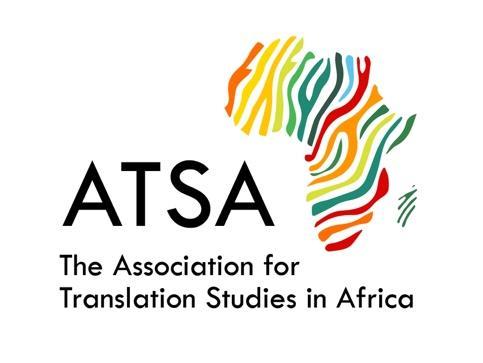
DavidOrrego-Carmona UniversityofWarwick/UniversityoftheFreeState
MarlieVanRooyen UniversityoftheFreeState
Conference Report: CATS Conference 2023
From 29 to 31 May 2023, the Canadian Association for Translation Studies (CATS) organized its annual conference at York University in Toronto. At EST we sometimes question the continental component in the name of our Society. CATS, however, shows again and again every year that even with a national component in the official designation, one can organize highly internationally- and intercontinentally-oriented conferences. The name refers to the origins and the tradition, not at all to its contemporary scope and outreach.
The fact that this was already the 35th CATS conference illustrates the important roles that Canadian researchers and universities – in particular, but not only in Quebec – have played in the development of TS. It is not a coincidence that EST has a long-standing protocol of understanding with its Canadian counterpart – an agreement that the CATS President Audrey Canalès explicitly referred to during her opening speech when welcoming the representatives of EST.
The long tradition in TS research, however, does not prevent the CATS conferences from including innovative approaches or testing the value of new trends and vogues in research. The May conference chose as its central title ‘Questioning the Universal Through Translation: Translating the Social Sciences and Humanities Today’, showcasing the focus on interdisciplinary exchanges between TS and the Social Sciences. Besides some 55 presentations in the program, there was also a keynote speech by Carolyn Shread on the ‘Plasticity of Thought in Translation’, focusing on the transformation of thought when translating.
Besides the more classic panel presentations and one keynote, more alternative formats were a round table discussion on the funding of translation in the humanities and social sciences and the book launch of Joshua Price’s TranslationandEpistemicide(University of Arizona Press, 2023). It zooms in on historical cases of translation that have (consciously or unconsciously) contributed to epistemic impoverishment or even destruction of knowledge. In that sense the book perfectly reflected the main theme of Questioning the Universal through Translation. Last but not least, the conference dinner was organized in honor of Brian Mossop, one of those many Canadian researchers with high scholarly productivity and a specific interest in the position of translation practice for the development of the TS discipline.
LucvanDoorslaer ESTvice-president UniversityofTartu/KULeuven
Summer School Report: The 34th CETRA Research Summer School
The 34th CETRA Research Summer School, held online from August 28 to September 8, 2023, featured two intensive weeks of interactive lectures, webinars, workshops, tutorials, and peer engagement to kickstart participants' doctoral projects. Established in 1989, it is the world's longestrunning advanced summer training program in Translation Studies. The CETRA Chair Professor for this year was Hanna Risku (University of Vienna), known for her pioneering work in the areas of translation and situated cognition, ethnography, translation workplace and network research, and translation expertise. Recordings of Professor Risku’s excellent CETRA Chair Lectures can be found on the CETRA blog
The 2023 CETRA Class had 25 participants from 12 countries. In a series of posts on X, formerly Twitter, Hanna Risku described participants’ wide range of research topics, methods, and approaches: “I was going through the topics and approaches of the CETRA Summer School PhD students and thought of the great diversity and breadth of our discipline. ❤�� Let me give you some examples....They study translation and interpreting practices, policies, processes, working conditions, technologies, distribution, chains, actors, contexts, histories; they analyse specialised and poetic language, legal, journalistic, audiovisual, literary and religious texts; in their PhDs, we will find qualitative and quantitative analyses, experiments, ethnographies and netnographies, text and corpus analyses; they use descriptive, functional, cognitive, sociological, linguistic, literary and other approaches to study translation, interpreting and beyond; including actor-network theory, activity theory, 4EA cognition, complexity theory; studying accessibility, syntactic structures, shifts, reception and production and beyond; and, of course, they study languages and cultures and contexts from all over the world, from Austria and Bolivia to China, Lithuania, Russia and Turkey. ��”
The CETRA teaching staff was equally diverse, with 23 professors from around the world. They offered one-on-one tutorials, webinars and workshops to help participants address challenges, refine research designs, and navigate academic life. A total of 80 tutorials were conducted during the two-week program. Webinars included “Methodological approaches in translation and interpreting research” by Franz Pöchhacker, “Revisiting and rethinking fundamental concepts in translation” by Sara Ramos Pinto, “Translation history” by Lieven D’hulst, “Translation and ideology” by Jeroen Vandaele, “Working with case studies” by Dilek Dizdar, and “Publishing in translation studies” by Dirk Delabastita. This year’s workshops, which allow participants to apply theoretical concepts in practical scenarios, included “Translation and cultural transfer” by Jack McMartin, “Retranslation” by Pieter Boulogne and Piet Van Poucke, “Translation and alternative concepts” by Luc van Doorslaer and Paola Gentile, “Interpreting” by Franz Pöchhacker, Heidi Salaets, and Geert Brône, and “Research impact and academia-industry collaboration” by Sara Ramos Pinto
Participants also presented their research in thematic panels chaired by CETRA staff. This year’s panels included: “Translation and gender”, “Translation and society”, “Interpreting”, “Translation and history”, “Translation and periodicals”, “Translation and multimodality”, “Translation and reception”, and “Translation and policy”. The presentations served as a conference-style experience and paved the way for potential inclusion in an edited volume in the CETRA book series, Translation,InterpretingandTransfer
As part of its commitment to reduce its carbon footprint and reach more early-career translation studies scholars around the world, the CETRA board recently took the decision to offer the CETRA Research Summer School in both online and on-campus editions. This year’s summer school was held online and will be followed by an on-campus edition in 2024. We will then continue to alternate between the two formats on a yearly basis.
We are pleased and honoured to announce that 2024 CETRA Chair Professor is Lynne Bowker (University of Ottawa), who is well known for her excellent teaching praxis, broad research profile in translation studies and specialized expertise in machine translation literacy, translation technology, translation pedagogy, and digital humanities. CETRA 2024 is set to take place August 19–30, and the call for applicants will open in January 2024. Stay tuned for more information on this exciting opportunity.
JackMcMartin CETRADirector

Summer School Report: The 2nd International Summer School on Cognitive Translation & Interpreting Studies
Endorsed by the EST and TREC, and supported by the International Doctoral Schools of the University of Murcia and the Polytechnic University of Cartagena, the Laboratory for Multilectal Mediated Communication & Cognition (MC2 Lab) held its 2nd International Summer School on Cognitive Translation & Interpreting Studies in June. The intense two-week, full-day, face-to-face program provided courses in cognitive translatology, cognitive linguistics, cognitive psychology and psycholinguistics, neuroscience, emotions, human-computer interaction as well as introductions to research methods and statistics. Attendees also had two one-to-one tutoring sessions with two faculty members each week. More details about the programme can be found on the summer school’s website
The summer school was co-directed by Ana María Rojo López and Ricardo Muñoz Martín, and the teaching faculty also included Sandra L. Halverson, Alexis Hervais-Adelman, Christopher Mellinger, Sharon O’Brien, Elisabet Tiselius, and Bogusława Whyatt. Additionally, debriefing and brainstorming sessions were facilitated by Álvaro Marín, Purificación Meseguer, Marina Ramos, and Raphael Sannholm.
The diverse group of attendees ranged from first-year PhD students to post-docs and research assistants, with some already holding positions at universities. They came from Belfast, Changsha, Durham, Galway, Hong Kong, Kristiansand, Leeds, Leuven, Manchester, Mons, Murcia, Olomouc, Poznań, Shanghai, Singapore, Swansea, and Vienna. The attendees were Antonia Baumann, Chen Hao, Anna B. Dimas Furtado, Du Meng, Chiara A. Gebbia, He Haoshen, He Sui, Jia Yichen, Li Xiaoye, Liu Xinyuan, Peng Xinyang, Thomas Prinzie, Cristina Roldán Torralba, Paulina J. Rozkrut, Silvia Terribile, Ewa Tomczak, Michaela Trlifajová, Mathieu Veys, María I. Vicente López, Wang Yifan, Xu Qiliang, and Xu Renwen.
The school was hosted by the business management school of the Polytechnic University of Cartagena, Spain, which boasts stunning views over the harbor. The social program included a visit to the Roman museum, the Roman theater, a short boat trip to a fortress on the other side of the harbor and concluded with a farewell dinner.
This not-for-profit initiative by the Laboratory for Multilectal Mediated Communication & Cognition (MC2 Lab) was costlier this time around. The fee was average for such extended events, but the cost of living did impact the overall expense. EST members in good standing received a discount on the registration fee, and the two MC2 Lab grants were awarded to Jia Yichen and Li Xiaoye.
A post-event survey indicated overall very high satisfaction among attendees, scoring 4.95 out of 5. In a scale from 1 (least) to 7 (most), faculty performance was rated at 6.6, instructors were considered inspiring and approachable (6.8), and the courses were deemed interesting and adequate, at 6.1. Some attendees found the content somewhat demanding, rating it at 5.1. The faculty was very happy as well. Eleven attendees submitted their research project papers, which are currently under review, so we cannot yet announce the winner of the EUR500 prize for the best research project, as determined by voting by TREC members.
The 3rd MC2 Lab Summer School, co-directed by Bogusława Whyatt and Ricardo Muñoz, is scheduled for July 2025 in Poznań, Poland. Ensure it's on your calendar! RicardoMuñozMartín MC2LabSummerSchoolCo-Director


Report by the EST Summer School Scholarship 2023 Recipient
I received the EST Summer School Scholarship to attend the summer school in translation history called ConceptualizingHistoriesofTranslation: FromyourStorytoHistoryorganized by the Department of Translation Studies of the University of Graz, Austria from 18th to 23rd September 2023. This summer school continued the tradition of the one previously organized by the Center for Translation Studies at the University of Vienna between 2017 and 2021 with the name TranslationinHistory–HistoryinTranslation
Having a project anchored in translation history, I felt that the summer school organized in Vienna would be the perfect forum to discuss my research with peers and experienced scholars. However, when I enquired about it last year, I was sad to hear that the current conditions would not allow the Viennese team to host it. For this reason, I was extremely happy to find out that the Department of Translation Studies in Graz decided to take over the organization of the summer school for 2023 with support from Vienna. I did not hesitate to apply, and I am very grateful for the opportunity of traveling to the beautiful city of Graz for an enriching and stimulating week.
The summer school brought together a diverse group of 17 PhD candidates from all over the world with a variety of topics concerned with translation history. The organizing team, comprising Hanna Blum, Pekka Kujamäki, and Rafael Schögler, was very welcoming and available throughout the whole week for research-related and practical questions. The aim of the summer school was to broaden our horizons by looking at the bigger picture of history, beyond the specificity of our single projects.
The first day was dedicated to getting to know each other with poster presentations followed by short discussions. The organizing team was very generous with the time and attention they dedicated to every research project. In particular, I appreciated that we were asked about our expectations and an open mind was kept towards our suggestions for the coming days. As a result, the organizers succeeded in creating a collegial, relaxed atmosphere where everyone felt part of the same research community.
On the following days, we had lectures, workshops, and individual tutorials not only with the organizing team but also with Anthony Pym (University of Melbourne), Nadja Grbic (University of Graz), Hephzibah Israel (University of Edinburgh), Larisa Schippel, Julia Richter, and Stefanie Kremmel (University of Vienna). The topics covered by the lectures varied from “Reflexive Empiricism” by Anthony Pym to “Why are we doing Translation History?” by Pekka Kujamäki through to “History as a ‘prop’ vs History as ‘active agent’” by Hephzibah Israel, to “Breaking the Habitus” by Larisa Schippel. All sessions aimed at stimulating our independent, critical thinking, reflexivity, and engagement by questioning our beliefs and opening up our minds to new ideas.
We were given the opportunity to choose freely between workshops and tutorials. Personally, I decided to participate in all the workshops since they all had different and fascinating topics – from “Sources and Triangulation” with Pekka Kujamäki to “Knowledge Exchange: Talking about your PhD to others” with Hephzibah Israel through to “Interpreting and deconstructing translation flows” with Rafael Schögler, “Oral History and Subjective Material” with Hanna Blum, and finishing with biographic and bibliographic approaches with Larisa Schippel, Julia Richter, and Stefanie Kremmel. However, I also signed up for as many tutorial sessions as I could to make the most out of this experience. As a result, I was able to exchange thoughts on my research project with five of the six available scholars. Coming to the summer school, I expected to get different perspectives on my subject as well as gain new insights. This is exactly what I am taking home with me. My ideas have been challenged while the foundation of my project has been validated through valuable, constructive feedback and comments. I believe that I could not have wished for a better outcome.
It was extremely inspiring to be able to listen to the personal experience of so many scholars, share my thoughts, doubts, and uncertainties with them and other PhD students. The organizing team did a great job in structuring the last day of the summer school with group work to look back on what we had learned throughout the week and by listening to our feedback. It was a pleasure to participate in this summer school, and I really hope that it will be organized again in the coming years so that more PhD students can profit from it.
Furthermore, I appreciated the opportunity to meet and engage in discussions with renowned personalities within Translation Studies and get to know other motivated and talented PhD candidates with whom I hope to stay in touch and develop future collaborations. The summer school was a great forum to come in contact with different types of research within translation history and with students from other academic backgrounds and levels.
In conclusion, I would like to thank the organizing team, the speakers, and all the participants in the summer school ConceptualizingHistoriesof Translation:FromyourStorytoHistoryfor a thought-provoking week which has helped me see my research project in a different light. But most of all, my thanks go to the European Society of Translation Studies for supporting me as a young researcher with their Summer School Scholarship.
GiadaBrighi PhDCandidateinTranslationStudies StockholmUniversity
UpcomingTSConferences
The list below is based on the EST list of conferences on the website. Thanks to David Orrego-Carmona for regularly compiling the list for us.
Date
Name
09/11/2023 Nothing Happened: Translation Studies before James Holmes
09/11/2023 Traduction et réhabilitation de voix oubliées France-Espagne/Espagne-France (XXe – XXIe s.) –Traducción y rehabilitación de voces olvidadas Francia-España/España-Francia (s. XX – XXI)
10/11/2023 Rewind and Fast Forward: Past, present and future scenarios in audiovisual translation
20/11/2023 45th Translating and the Computer
22/11/2023 4th International Symposium PaCor 2023: Parallel Corpora Across Disciplines: New Challenges Ahead
23/11/2023 IPCITI 2023 The International Postgraduate Conference in Translation and Interpreting
24/11/2023 Translation (auto)censored in the French-speaking worlds since 1945 (Saint Etienne) –Traduction (auto)censurée dans les mondes francophones depuis 1945 (Saint Étienne)
28/11/2023 ENTRAD 2022 – XIV Encontro Nacional de Tradutores e VIII Encontro Internacional de Tradutores
30/11/2023 GDA Green Digital Accessibility. Where Accessibility meets Sustainability
08/12/2023 Translation Studies and Digital Humanities
10/12/2023 Decision-making in translation: attitudes and representations
13/12/2023 Epistemic Translation: Towards an Ecology of Knowledges
11/01/2024 Creativity and Translation in the Age of Artificial Intelligence
25/01/2024 6e Colloque Le français parlé les medias : Pratiques langagières non standardisées, attitudes et représentations dans les formats médiatiques oraux associés au divertissement
08/02/2024 Ecrire, traduire la mode / Writing, translating fashion
05/04/2024 ATISA XI Conference, Trajectories of translation and interpreting studies: Between the digital and the post national
12/04/2024 International Conference on Translation Education. Digital Translation Studies: Pedagogy, Research, Publication
17/04/2024 2nd International Conference on Translation and Cultural Sustainability: Challenges and New Avenues
30/05/2024 10th INPRA: International Conference on Intercultural Pragmatics and Communication
10/06/2024 Redefining translation? Historical fluctuations, new practices, and epistemologies in the making
Country Link
UK Site
France Site
Italy Site
Luxemburg Site
Spain Site
UK Site
France Site
Brazil Site
Spain Site
Hong Kong Site
Algeria Site
Portugal Site
Austria Site
Canada Site
USA Site
Singapore Site
Hong Kong Site
Spain Site
Italy Site
Canada Site
08/09/2024 International Congress of Linguists: Cognitive Translation & Interpreting Studies (CTIS) stream Poland Site
30/06/2025 11th EST Congress: The Changing Faces of Translation and Interpreting (Studies)
10/12/2025 8th IATIS International Conference: Translation and Intercultural Studies in the Age of Artificial Intelligence: Opportunities and Challenges
UK Site
Oman Site
NewPublications
Books

SystematicallyAnalysingIndirect Translations
By: James Luke Hadley
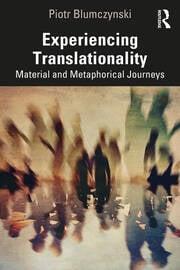
ExperiencingTranslationality
By: Piotr Blumczynski

TranslatingSimonedeBeauvoir’sThe SecondSex
By: Julia C. Bullock & Pauline HenryTierney (eds.)

TheRoutledgeHandbookofTranslation TheoryandConcepts
By: Reine Meylaerts & Kobus Marais (eds.)
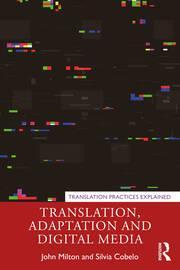
Translation,AdaptationandDigitalMedia
By: John Milton & Silvia Cobelo.

LiteraryTranslationResearchinChina
By: Roberto A. Valdeón & Youbin Zhao (eds.)

Übersetzungswissenschaft
By: Holger Siever

Qualifizierungnichtprofessioneller Sprachmittler By: Conchita Otero Moreno

Notassobreenseñanza,discapacidad auditivaytraducciónaccesible
By: Rocío Ávila Ramírez

Traducciónyparatraduccióndelodio
By: Karl Schurster & Óscar FerreiroVázquez (eds.)

ThreeHundredChineseCutVerseswith EnglishTranslations
By: Yongsheng Chen

APoliticalThesaurusforInterpretersand Translators
By: Abdulaziz Almaosherji

L’aspectculturelentraductionjuridique
By: Jorge Valdenebro Sánchez
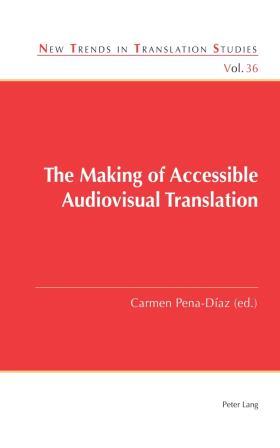
TheMakingofAccessibleAudiovisual Translation
By: Carmen Pena-Díaz (ed.)

Metatranslation. EssaysonTranslationandTranslation Studies
By: Theo Hermans
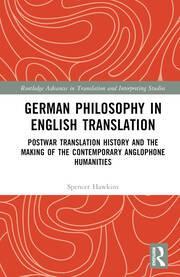
GermanPhilosophyinEnglishTranslation. PostwarTranslationHistoryandtheMaking oftheContemporaryAnglophone Humanities
By: Spencer Hawkins

FuzzyLanguageinLiteratureand Translation By: Lu Shao

ConferenceInterpretinginChina. Practice,TrainingandResearch
By: Riccardo Moratto & Irene A. Zhang (eds.)

InstrumentalisingForeignLanguage PedagogyinTranslatorandInterpreter Training.Methods,goalsandperspectives
By: Olaf Immanuel Seel, Silvia Roiss & Petra Zimmermann-González (eds.)

UnderlyingRhythm.OnTranslation, Communication,andLiteraryLanguages. EssaysinHonorofBurtonPike
By: Peter Constantine, Robert Cowan, Henry Gifford, Genese Grill & James Keller (eds.)

AudiovisualTranslation– Subtitlesand Subtitling.TheoryandPractice
By: Laura Incalcaterra McLoughlin, Marie Biscio & Aine Ní Mhainnín (eds.)
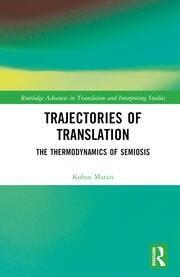
TrajectoriesofTranslation TheThermodynamicsofSemiosis By: Kobus Marais
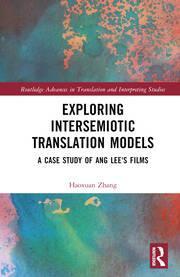
ExploringIntersemioticTranslationModels. ACaseStudyofAngLee'sFilms By: Haoxuan Zhang

ProfessionalInterpretingProgrammesin China.ConstructingaCurriculum ImprovementModel By: Yinying Wang

Dialect,Voice,andIdentityinChinese Translation.ADescriptiveStudyofChinese TranslationsofHuckleberryFinn,Tess,and Pygmalion By: Jing Yu
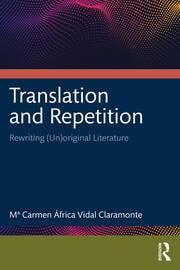
TranslationandRepetition.Rewriting (Un)originalLiterature By: Mª Carmen África Vidal Claramonte

OfPeninsulasandArchipelagos.The LandscapeofTranslationinSoutheastAsia By: Phrae Chittiphalangsri & Vicente L. Rafael (eds.)

ColonialAuthorityandTamiḻScholarship.A StudyoftheFirstEnglishTranslations
By: C T Indra & Prema Jagannathan (eds.)
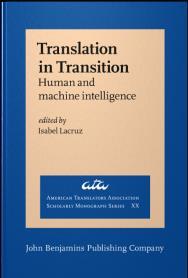
TranslationinTransition.Humanand machineintelligence
By: Isabel Lacruz (ed.)

EmergingFieldsinEasyLanguageand AccessibleCommunicationResearch
By: Silvana Deilen, Silvia Hansen-Schirra, Sergio Hernández Garrido, Christiane Maaß & Anke Tardel (eds.)

DieEntdeckungWalterBenjaminsinChina. ZueinerTheoriedesPolitischenin ÜbersetzungundNeuübersetzung
By: Nannan Liu

ÜbersetzungsprozesseimKontextvonExil undPostmigration
By: Stephanie Baumann, Irène Cagneau & Nadine Rentel (eds.)

NewPathsinTheatreTranslationand Subtitling
By: Vasiliki Misiou & Loukia Kostopoulou (eds.)

QuestionsforTranslationStudies By: Douglas Robinson
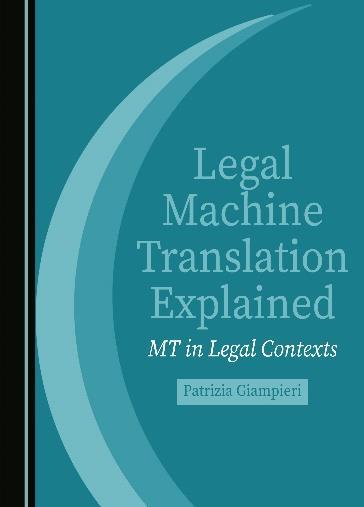
LegalMachineTranslationExplained:MTin LegalContexts
By: Patrizia Giampieri
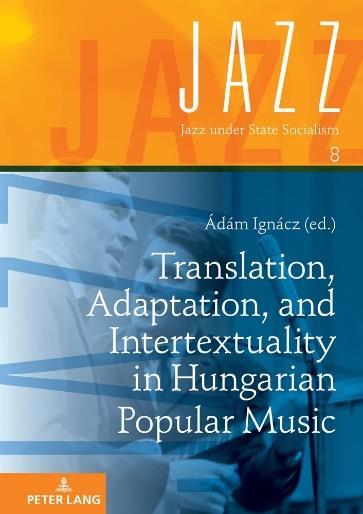
Translation,Adaptation,andIntertextuality inHungarianPopularMusic
By: Ádám Ignácz (ed.)

LiteraturesoftheWorldandtheFutureof ComparativeLiterature:Proceedingsofthe 22ndCongressoftheInternational ComparativeLiteratureAssociation
By: Péter Hajdu & Xiaohong Zhang (eds.)

ADeafTakeonNon-EquivalenceinWritten ChineseTranslation
By: Chan Yi Hin

InteractionalDynamicsinRemote Interpreting:Micro-analyticalApproaches
By: Esther de Boe, Jelena Vranjes & Heidi Salaets (eds.)
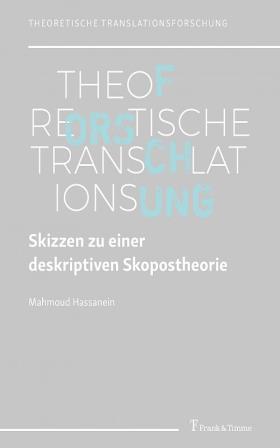
SkizzenzueinerdeskriptivenSkopostheorie
By: Mahmoud Hassanein
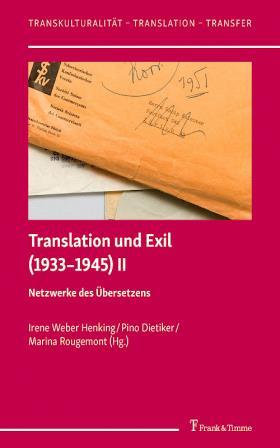
TranslationundExil(1933–1945)II
By: Irene Weber Henking, Pino Dietiker & Marina Rougemont (eds.)
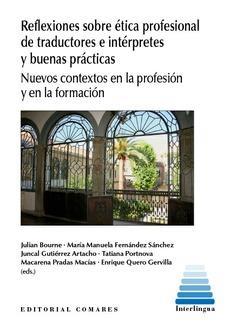
Reflexionessobreéticaprofesionalde traductoreseintérpretesybuenas prácticas
By: Julian Bourne, M.ª Manuela Fernández Sánchez, Juncal Juncal Gutiérrez Artacho, Tatiana Portnova, E. Macarena Pradas Macías & Enrique Quero Gervilla (eds.)
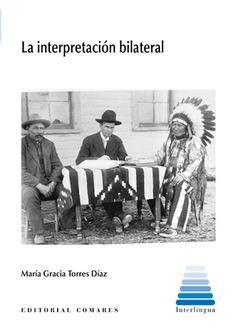
Lainterpretaciónbilateral
By: María Gracia Torres Díaz

Latraducciónaudiovisualatravésdela traducciónautomáticaylaposedición
By: Laura Mejías-Climent & Julio de los Reyes Lozano (eds.)

Estudioslingüísticosentornoalpapelde lasmujerestraductorasenlahistoria
By: Adela González Fernández (dir.), Juan Miguel González Jiménez & Sergio Rodríguez-Tapia (eds.)

EducatingCommunityInterpretersand TranslatorsinUnprecedentedTimes
By: Miranda Lai, Oktay Eser & Ineke Crezee (eds.)
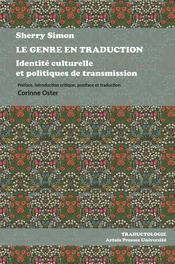
LeGenreentraduction.Identitéculturelle etpolitiquesdetransmission
By: Sherry Simon (author) & Corinne Oster (translator)
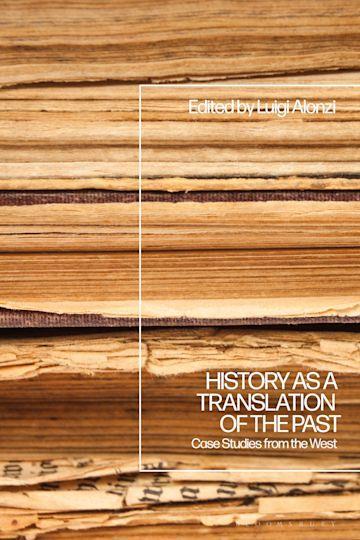
HistoryasaTranslationofthePast CaseStudiesfromtheWest
By: Luigi Alonzi (ed.)

TranslationFlows.Exploringnetworksof people,processesandproducts
By: Ilse Feinauer, Amanda Marais & Marius Swart (eds.)
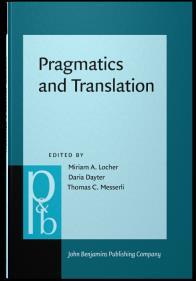
PragmaticsandTranslation
By: Miriam A. Locher, Daria Dayter & Thomas C. Messerli (eds.)
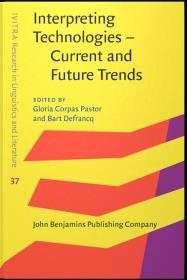
InterpretingTechnologies– Currentand FutureTrends
By: Gloria Corpas Pastor & Bart Defrancq (eds.)

SchlichtheitundAvantgardeinFederico GarcíaLorcasPrimerromancerogitano
By: Jutta Seeger-Vollmer

TranslatingMinoritiesandConflictin Literature.Censorship,CulturalPeripheries, andDynamicsofSelfinLiteraryTranslation
By: María Luisa Rodríguez Muñoz & Paola Gentile (eds.)

ExploringtheFundamentalFeaturesof Translation:AGuideforSpecialistsand Non-Specialists
By: Nabil Al-Awawdeh

ExploringPostcolonialAspectsof
Translation
By: Alaoui Hichami Taoufik
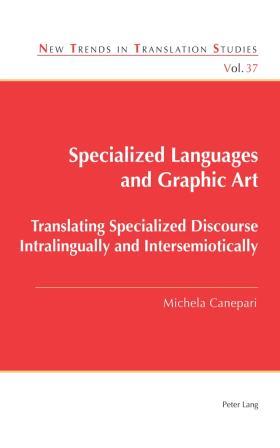
SpecializedLanguagesandGraphicArt
TranslatingSpecializedDiscourse IntralinguallyandIntersemiotically
By: Michela Canepari

Avant-GardeTranslation
By: Alexandra Lukes (ed.)

AudioDescriptionfortheArts ALinguisticPerspective
By: Elisa Perego

The Routledge Handbook of Korean Interpreting By: Riccardo Moratto & Hyang-Ok Lim (eds.)
Special Issues of TS Journals
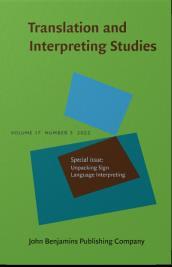
Translation and Interpreting Studies UnpackingSignLanguageInterpreting
Edited by: Hilde Haualand, Maartje De Meulder & Jemina Napier Volume 17, no. 3 (2022)
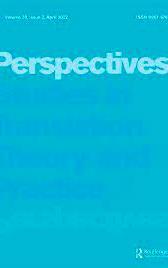
Perspectives
TranslationinTimesofCrisesandConflicts
Edited by: Roberto A. Valdeón Volume 31, no. 3 (2023)

Translation Review TranslationasCommunity
Edited by: Clare Sullivan Volume 115, no. 1 (2023)

MonTI
Traduccionesdelaslenguasclásicasyde lostextossagrados.Hermenéuticasy metodologías
Edited by: Luis Pomer Monferrer, Katarzyna Starczewska & Ioannis Kioridis Volume 15 (2023)

Palimpsestes
LeMoyenÂgeauprismedelatraductionet delaréécriturecontemporaines
Edited by: Isabelle Génin & Jessica Stephens Volume 36 (2022)

Translation and Translanguaging in Multilingual Contexts
AudiovisualTranslationandMedia AccessibilityinLanguageLearning Contexts.MultipleModes,Innovative PracticesandFurtherExplorations
Edited by: Marina Manfredi, Catia Nannoni & Rosa Pugliese Volume 9, no 2 (2023)

The Translator TranslatingHazards
Edited by: Federico M. Federici Volume 28, no. 4 (2022)

Translation Studies
TheConceptualisationofTranslationin TranslationStudies:Past,Presentand Future
Edited by: Sergey Tyulenev, Binghan Zheng & Kobus Marais Volume 16, no. 2 (2023)

Status Quaestionis
TheImaginaryVoyage:New,Other,Virtual Worlds
Edited by: Francesco de Cristofaro & Riccardo Antonangeli Volume 24 (2023)

inTRAlinea ReimaginingComics– TheTranslationand LocalizationofVisualNarratives
Edited by: Michał Borodo (2023)

Traduire Enquêted’équilibre
Edited by: Carine Bouillery & MarieCéline Georg 248 (2023)
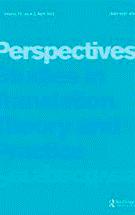
Perspectives
Past,PresentandFutureTrendsin (Researchon)IndirectLiteraryTranslation
Edited by: Laura Ivaska, Hanna Pięta & Yves Gambier Volume 31, no. 5 (2023)

The Translator EthnographicResearchinTranslationand InterpretingStudies
Edited by: Maialen Marin-Lacarta & Chuan Yu
Volume 29, no. 2 (2023)
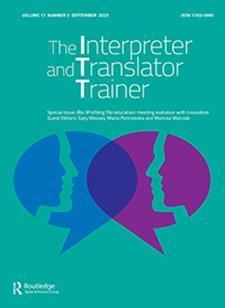
The Interpreter and Translator Trainer (Re-)profilingT&IEducation:Meeting EvolutionwithInnovation
Edited by: Gary Massey, Maria Piotrowska & Mariusz Marczak Volume 17, no. 3 (2023)

Clina TeachingandEvaluationofSpecialized TranslationandInterpreting
Edited by: Ondřej Klabal & Beatriz de la Fuente Marina
Volume 9, no. 2 (2023)
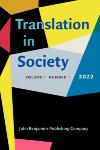
Translation in society ConstructingtheLiteraryTranslatorasa Brand
Edited by: Wenqian Zhang Volume 2, no. 3 (2023)
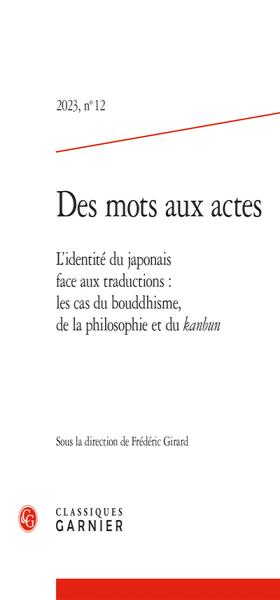
Des mots aux actes L’identitédujaponaisfaceauxtraductions: lescasdubouddhisme,delaphilosophieet dukanbun
Edited by: Frédéric Girard Volume 12 (2023)

Babel
LiteraryTranslationintheEraofArtificial Intelligence.ChallengesandItsFuture Prospects
Edited by: Wang Ning & Wang Hongtao Volume 69, no. 4 (2023)

Target AudiovisualTranslationintheAgeof Streaming
Edited by: Jinsil Choi, Kyung Hye Kim & Jonathan Evans Volume 35, no. 3 (2023)
MembershipInformation
The membership fee is EUR 35 per year for full members and EUR 80 for a threeyear period. It is EUR 75 for supporting members (sponsors). It is due by 31 March each year, but late payments are always welcome.
To renewyourmembership, please follow our instructions on the EST website.
AbouttheESTNewsletter

We’re on the Web! Checkusoutat: www.est-translationstudies.org
TheESTNewsletteris published twice a year, in May and November. It is basically a vehicle for communication between EST members and a catalyst for action, rather than a journal. It provides information on EST activities and summarizes some of the information available on the EST website, the EST Twitter account and Facebook group – you are invited to go to those sites for information that is more specific and up-to-date. The Newsletterreports on research events and presents suggestions on EST matters and research issues. All comments and suggestions from readers are welcome. All correspondence relating to the Newsletter should be sent to: secretary-general@esttranslationstudies.org
